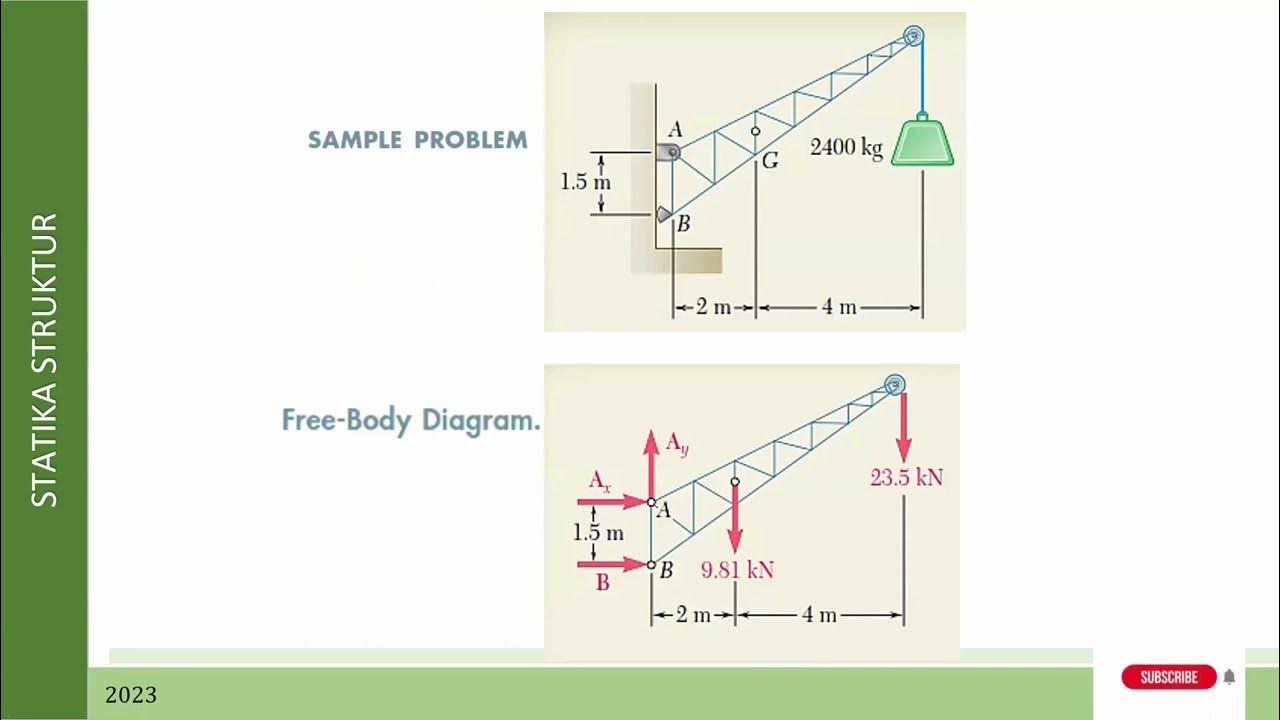Mekanika Statis Tentu: Struktur dan Elemen Bangunan
Summary
TLDRThis video introduces the fundamentals of structural mechanics, focusing on roof trusses and steel frame structures. It explains key components such as beams, columns, plates, and foundations, highlighting their roles in load transfer within a building. The script also delves into the classification of structures like roof trusses, which consist of joints and beams, and steel frames, which include plates, beams, and columns. The video provides a detailed analysis of how forces are transferred from the roof to the foundation, emphasizing the interconnectivity of structural elements in both wooden and steel-frame buildings.
Takeaways
- 😀 The introduction explains the topic of structural mechanics and its focus on roof trusses and steel frames.
- 😀 Roof trusses are typically made of either light steel (Galvalume) or wood, with each material offering different properties for construction.
- 😀 A 2D drawing of a wooden roof truss illustrates the structure, showing straight lines representing wooden beams.
- 😀 A roof truss structure can be classified into two main components: the joints (called 'buhul' in the script) and the beams that form the frame.
- 😀 Joints or buhul are the connection points where beams meet and can be the points where load is applied to the structure.
- 😀 The steel frame structure is presented as another common type of building framework, comprising plates, beams, and columns.
- 😀 Plates in steel frame structures help to resist live loads applied to the building, typically in the form of flat sheets or panels.
- 😀 Beams are horizontal structural elements that support plates and transfer loads towards the columns.
- 😀 Columns are vertical elements that distribute the load from beams and plates down to the foundation.
- 😀 The foundation at the bottom of the structure transmits the building's load into the earth, ensuring stability.
- 😀 A load transfer mechanism is described, where load moves from the roof trusses to columns, beams, and ultimately to the foundation, ensuring the building’s structural integrity.
Q & A
What is the first topic covered in the video script?
-The first topic covered in the video is the introduction to structural components in civil engineering, specifically roof trusses.
What are the two types of roof trusses mentioned?
-The two types of roof trusses mentioned are made of light steel or galvalume (on the left) and wood (on the right).
How are the wooden roof trusses represented in the script?
-The wooden roof trusses are represented in a two-dimensional drawing, where the actual wooden elements are replaced with straight lines to form a pattern resembling the original structure.
What are the two key elements of a roof truss?
-The two key elements of a roof truss are the joints (or nodes) and the beams (or bars).
What function do the joints or nodes serve in a roof truss?
-The joints or nodes are the points where the beams meet and where loads are applied to ensure the structure works as intended.
What is a steel frame structure and what distinguishes it from other structures?
-A steel frame structure consists of three main components: plates, beams, and columns. It is distinguished from other structures by the presence or absence of plates, with one version being open and the other slightly enclosed.
What are the components of a steel frame structure?
-The components of a steel frame structure are plates, beams, and columns.
How does load transfer occur in a building structure?
-Load transfer in a building structure occurs through a sequence where loads are first applied to the plate, transferred to the beams, then to the columns, and ultimately to the foundation, which transfers the load to the ground.
What happens to the load in a two-story building when the roof truss is considered?
-In a two-story building with a roof truss, the load from the roof is transferred through the trusses to the columns, and then to the foundation, with each component sharing the load.
What is the role of the foundation in load transfer?
-The foundation's role in load transfer is to receive the loads from the columns and transfer them to the ground, ensuring the stability of the building.
Outlines

Этот раздел доступен только подписчикам платных тарифов. Пожалуйста, перейдите на платный тариф для доступа.
Перейти на платный тарифMindmap

Этот раздел доступен только подписчикам платных тарифов. Пожалуйста, перейдите на платный тариф для доступа.
Перейти на платный тарифKeywords

Этот раздел доступен только подписчикам платных тарифов. Пожалуйста, перейдите на платный тариф для доступа.
Перейти на платный тарифHighlights

Этот раздел доступен только подписчикам платных тарифов. Пожалуйста, перейдите на платный тариф для доступа.
Перейти на платный тарифTranscripts

Этот раздел доступен только подписчикам платных тарифов. Пожалуйста, перейдите на платный тариф для доступа.
Перейти на платный тариф5.0 / 5 (0 votes)






